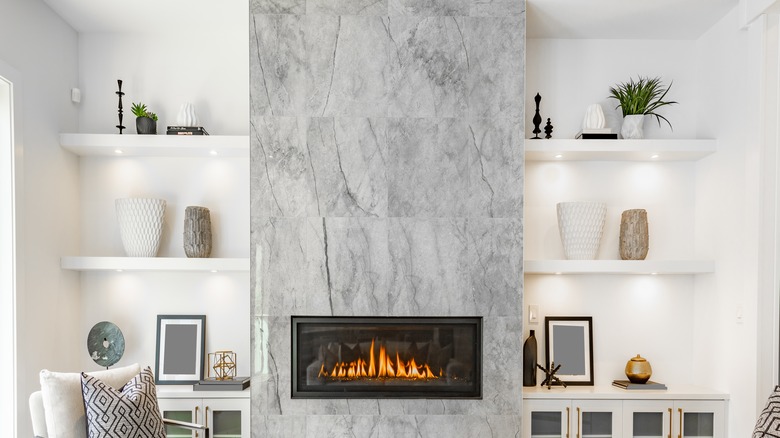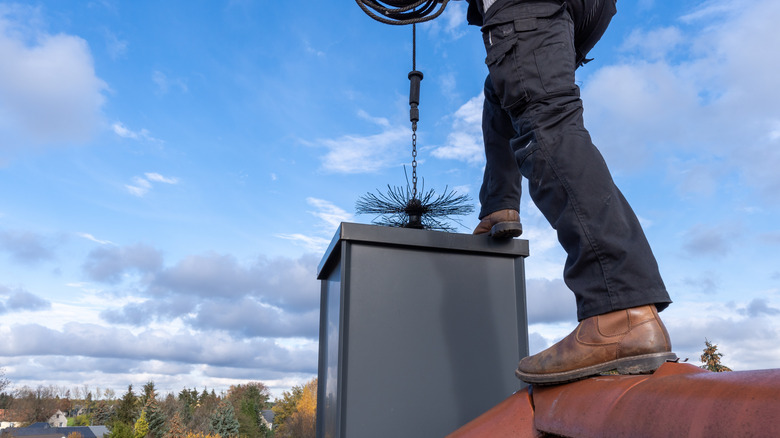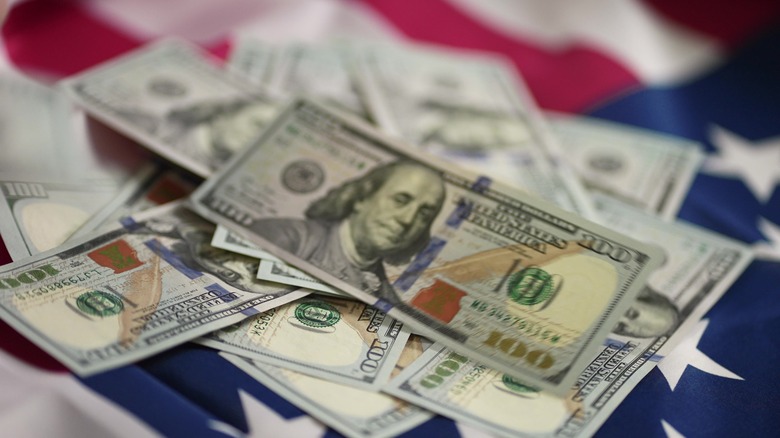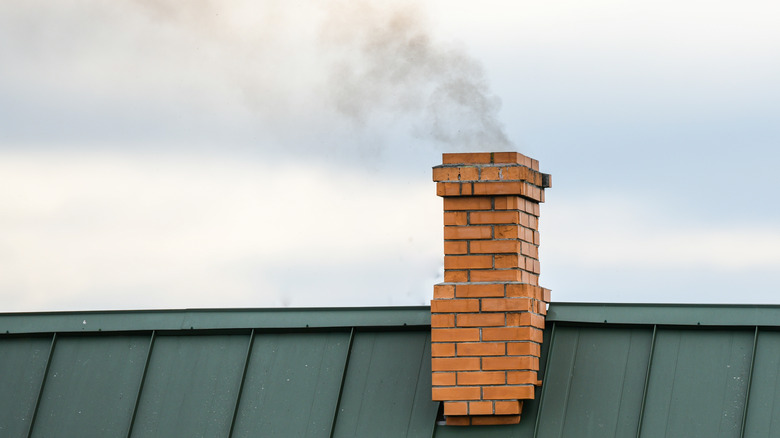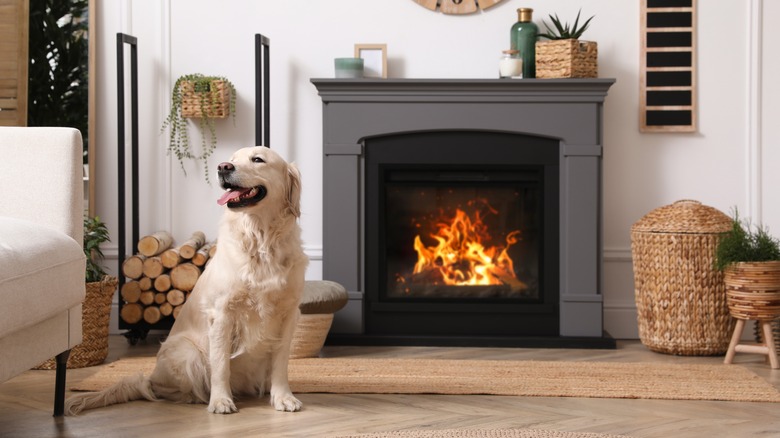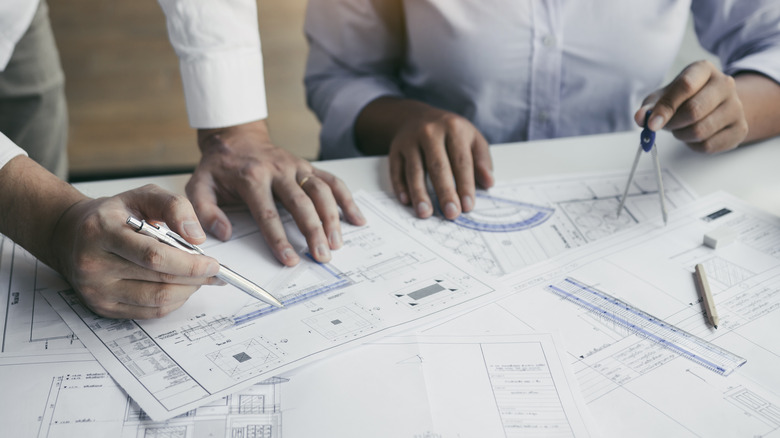Why You Should Reconsider Adding A Fireplace To Your Space
As the colder weather begins to roll in, you may find yourself daydreaming about the cozy crackling of a fireplace. Memories of roasting marshmallows, stories of Santa Claus, and movies with old-timey cabins covered in a coat of fresh snow may come to mind, but the reality is far less glamorous. So before you start ferociously Googling living room renovations and planning your next holiday photoshoot in front of the fireplace, take a moment to consider the practical implications of installing such a major piece of equipment in your home.
According to Fixr, the average cost to install a brick, wood-burning fireplace ranges from $3,000 to $20,000, with gas models sporting a slightly lower price tag. Either way, it's a big investment with a fairly minimal return. Keep reading to learn why a fireplace might not be everything you dreamed of and why it might be a better idea just to host a bonfire in your backyard instead.
A ton of maintenance
Having a fireplace itself isn't all that much work after installation, but if you ever want to actually use it, there's a lot of upkeep that you have to do. After all, you are dealing with an open flame in your home. According to True Value, you should be routinely cleaning out your firebox and removing ash that builds up, as well as scrubbing off any soot stains with a wire brush.
Creosote, or residue from wood, can also build up along the inside of the chimney. This can block airflow and also present some dangers because it's such a combustible material, so it's best to check that everything is in tip-top shape before burning and hire a chimney sweep at least once a year to prevent any issues. Additionally, there's the maintenance of the chimney itself. Making sure everything is properly sealed and functioning can prevent issues like debris from outdoors coming in, sparks coming out, and water or rain from seeping through. Having a chimney may look like an easy job, but it requires near-constant upkeep to ensure everything runs safely and smoothly.
Low return on investment
As with any major investment, weighing the price and benefits is important. Installing a fireplace will run you several thousand dollars, not including the cost of upkeep and firewood (via Fixr). If you live in a warmer climate or don't see yourself using it more than a few times a year, the investment probably won't pay off over time.
On the other hand, if you're planning to sell your home eventually, a fireplace can add a bit of value. Most homeowners nowadays don't view this installation as an essential element thanks to the prevalence of heating systems, however, so the benefits are nominal at best. Moreover, if it's in bad shape and needs repairs when it comes time to sell, it can even detract from the home's value. So, unless you're truly committed to using and maintaining your fireplace, the likelihood that it will feel like a worthy investment down the line is low.
Not environmentally friendly
According to the United States Environmental Protection Agency, 90% of the heat produced in a fireplace is released through the chimney, while only 10% actually makes its way into the home. As a result, they're more used for secondary heating and ambiance than anything else, and the bulk of actual heat produced is wasted. Other options, like an EPA-certified wood stove, fireplace insert, or fireplace retrofit, can help reduce that wasted heat and the pollution that comes from burning wood.
While it may seem safe because it's natural, wood smoke is made of microscopic particles and gases and can contain dangerous chemicals like benzene, formaldehyde, acrolein, and polycyclic aromatic hydrocarbons (via EPA). Smoke in the air can also be damaging for those with asthma and certain heart conditions and contributes to smog and decreased visibility in cities. The smell of a crackling fireplace may be pleasant, but it causes a lot more damage than good. You might be better off sticking with that campfire-scented candle.
Potential hazards
Having a fireplace seems cozy and comforting, but the risk becomes a bit more apparent when you realize it's an open flame in your home. Pets, small children, and any nearby fabrics or flammable materials can present obvious issues, but if your fireplace isn't properly maintained and cared for, there can be even more issues. Creosote buildup is a major cause of house fires, and improperly put-out flames can easily spark back up and relight. Unless you're willing to wait the recommended five hours after extinguishing a flame to go to bed, you would be putting yourself at risk and potentially joining the 87% of accidents caused by confined flames (via the EPA).
In addition to the house fire risk, gas fireplaces can carry the risk of carbon monoxide poisoning. According to the Centers for Disease Control and Prevention, at least 430 people die, and 50,000 people are sent to the emergency room in the United States with accidental carbon monoxide poisoning each year. Fireplaces can be safe if you're sure to follow the rules, but one slip up, and you could be playing with fire — literally.
Strict building codes
Even if you've decided that you're still willing to risk it for a fireplace, it simply might not be possible. Many cities have placed restrictions on or completely banned the installation of new fireplaces because of their environmental impact (via Fireplace Tips). Even if there are no bans in your city, your home itself might not be able to fit this installation and all of the necessary components. Getting a fireplace involves much more than a simple revamp, like replacing your cabinets, so if you're not ready for a complete overhaul, consider an outdoor fire pit or electric fireplace that just mimics the look of flames without the fuss.
As with any home improvement project, the decision to install this piece lies in the hands of the homeowner. If you're truly committed to the use and upkeep, it may eventually pay off in the end, but anything less, and you'll likely find yourself with a festive money pit.
